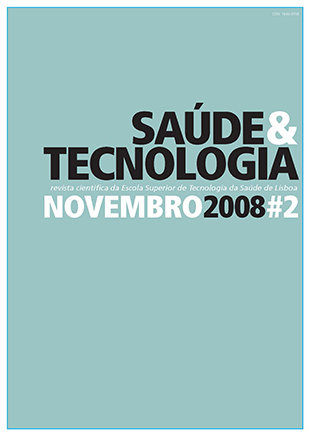Resident population in a psychiatric hospital: a vision health
DOI:
https://doi.org/10.25758/set.124Keywords:
Psychiatric illness, Ocular medication, Alterations, AmetropiasAbstract
Introduction - In a pioneering attempt in Portugal to characterize the state of the vision of the resident patients of a Psychiatric Hospital, it tried to identify the existence of ophthalmic alterations in this population, that could compromise the functioning of the visual system and with negative repercussions in the activities of the daily life; to characterize and to correct ametropias; to characterize/to relate the pathologies found with the medication and to select/to direct the patients for Ophthalmology consultation. Methods - 254 resident patients in a Psychiatric Hospital in Lisbon had been examined, with diagnosis in the scope of mental health, the capacity of displacement, and some autonomy, in order to detect ocular anomalies for the study of the visual acuity, ocular movements, cover test, prismatic cover test, near point of convergence, stereopsis, chromatic vision, previous and posterior segment, ocular tension and refractive study, with 100 individuals. Results - The majority of the patient was of the masculine sex (64.2%). The most found psychiatric pathology was schizophrenia (47.24%). Only 20.87% of the sample already had been observed in an ophthalmic consultation. Significant alterations on the level of the previous segment had been found (33.86% of cataracts); on the visual acuity, especially for near, in OD e OE (26.38%). The refractive study resulted in the prescription of 75 lenses, which improved the visual acuity significantly for near, in the interval of the luminous perception to 6/10, diminishing the number of individuals of 50 to 3. Conclusions - This tracing allowed many of the founded alterations to be treated after the correction of the ametropias, thus allowing this population to use its vision in the best way, an increased of the quality of life of these patients.
Downloads
References
OMS. Saúde mental: nova concepção, nova esperança – Relatório mundial da saúde [Internet]. Genebra: OMS; 2001 [cited 2006 Sep 22]. Available from: www.who.int/whr/2001/en/whr01_ch2_po.pdf. Portuguese
Bento A, Carreira M, Heitor MJ. Censo psiquiátrico de 2001: síntese dos resultados preliminares [Internet]. Lisboa: Direcção-Geral da Saúde; [s.d.] [cited 2006 Sep 22]. Available from: www.dgs.pt/upload/membro.id/ficheiros/i006006.pdf. Portuguese
Direcção-Geral da Saúde. Plano nacional de saúde 2004–2010: mais saúde para todos. Vol. II: orientações estratégicas [Internet]. Lisboa: DGS; 2004 [cited 2006 Sep 22]. Available from: www.dgsaude.pt/upload/membro.id/ficheiros/i006757.pdf#search=%22dgs%20Censo%20Psiquiatrico%202001%20resultados%20finais%22. Portuguese
Direcção-Geral da Saúde. Rede de referenciação de psiquiatria e saúde mental [Internet]. Lisboa: DGS; 2004 [cited 2006 Sep 12]. Available from: www.dgsaude.pt/upload/membro.id/ficheiros/i007439.pdf#search=%22rede%20de%20referencia%C3%A7%C3%A3o%20de%20psiquiatria%20e%20saude%20mental%22. Portuguese
WHO. Mental health in Europe: country reports from the WHO European Network on Mental Health [Internet]. Geneva: WHO; 2001 [cited 2006 Sep 12]. Available from: www.euro.who.int/document/E76230.pdf
Punukollu B, Phelan M. Visual acuity and reported eye problems among psychiatric in-patients. Psychiatr Bull R Coll Psychiatr [Internet]. 2006 [cited 2006 Sep 25];30(8):297–9. Available from: pb.rcpsych.org/cgi/reprint/30/8/297
Direcção-Geral da Saúde. Plano nacional de saúde 2004–2010: aumento da prevalência das doenças oculares com respostas descoordenadas [Internet]. Lisboa: DGS; 2004 [cited 2006 Sep 15]. Available from: www.dgsaude.minsaude.pt/pns/vol2_226.html. Portuguese
Patel M. Ocular side effects of drugs – Part 7a: drugs for the central nervous system. Optom Today [Internet]. 2003 Apr 18 [cited 2006 Sep 19]:36–9. Available from: www.optometry.co.uk/articles2003.php
Duke-Elder S. Refracção prática. 10ª ed. Rio de Janeiro: Rio Med Livros; 1997.
Smith D, Pantelis C, McGrath J, Tangas C, Copolov D. Ocular abnormalities in chronic schizophrenia: clinical implications. Aust N Z J Psychiatry. 1997 Apr;31(2):252–6.
von Noorden GK. Binocular vision and ocular motility: theory and management of strabismus. 6th ed. St. Louis: Mosby; 2002.
Ballone GJ. PsiqWeb: psiquiatria geral [Internet]. PsiqWeb; 2003 [cited 2006 Feb 10]. Available from: http://virtualpsy.locaweb.com.br/index.php. Portuguese
Downloads
Published
Issue
Section
License
Copyright (c) 2023 Saúde e Tecnologia

This work is licensed under a Creative Commons Attribution-NonCommercial-NoDerivatives 4.0 International License.
The journal Saúde & Tecnologia offers immediate free access to its content, following the principle that making scientific knowledge available to the public free of charge provides greater worldwide democratization of knowledge.
The journal Saúde & Tecnologia does not charge authors any submission or article processing charges (APC).
All content is licensed under a Creative Commons CC-BY-NC-ND license. Authors have the right to: reproduce their work in physical or digital form for personal, professional, or teaching use, but not for commercial use (including the sale of the right to access the article); deposit on their website, that of their institution or in a repository an exact copy in electronic format of the article published by Saúde & Tecnologia, provided that reference is made to its publication in Saúde & Tecnologia and its content (including symbols identifying the journal) is not altered; publish in a book of which they are authors or editors the total or partial content of the manuscript, provided that reference is made to its publication in Saúde & Tecnologia.







